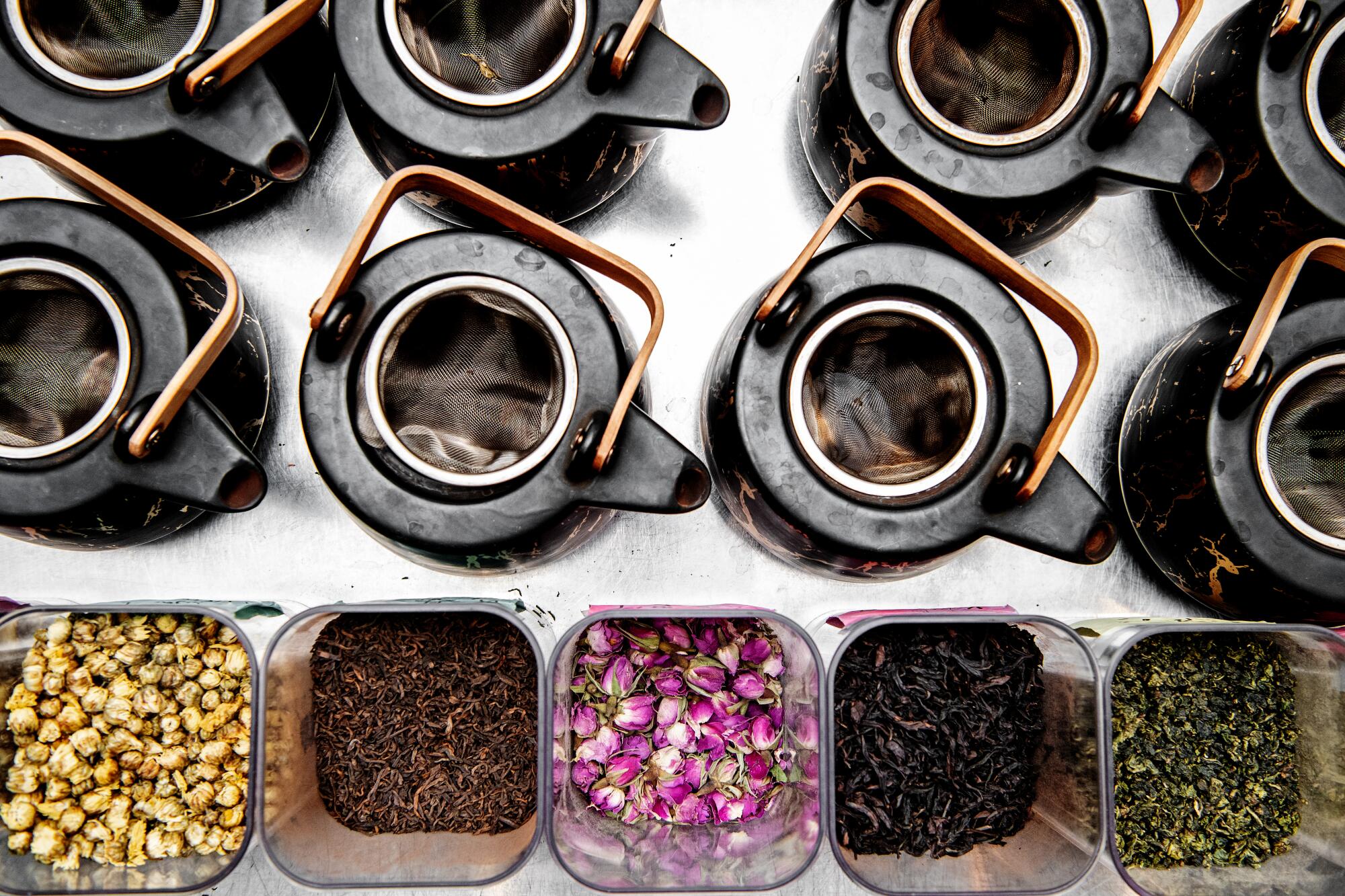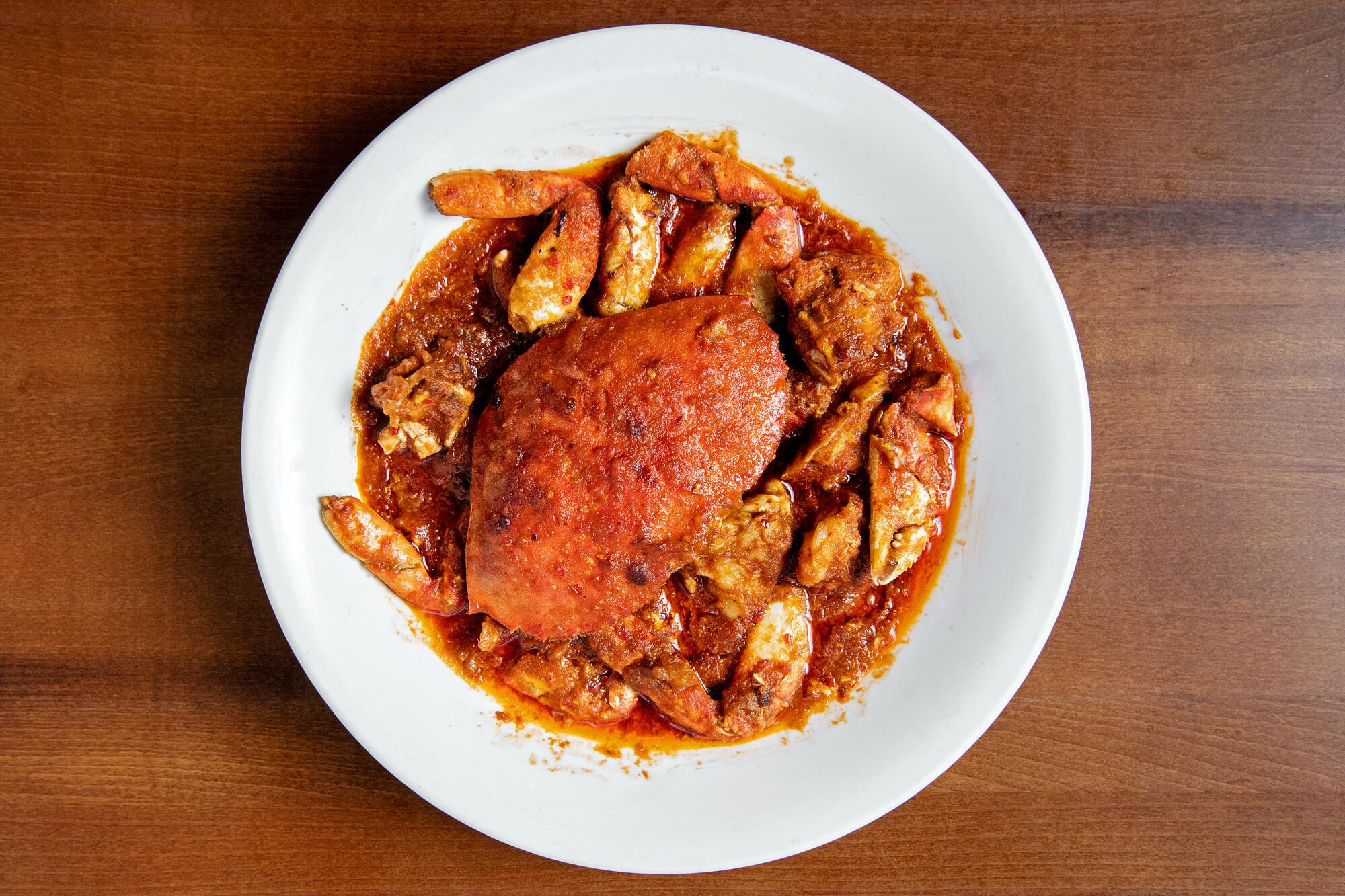
No cuisine is a monolith, and that seems especially true in the case of Cantonese cooking across Los Angeles right now. As some of its expressions disappear, others unfurl.
The audience for the San Gabriel Valley’s grand 20th century banquet halls wanes while cha chaan teng, a genre of restaurant derived from Hong Kong’s diner-like teahouses, thrives at places like Henry’s Cuisine in Alhambra (No. 42 on the most recent 101 Best Restaurants in L.A. list). Then there are the dim sum stalwarts, and specialists in Chiu Chow cooking from Guangdong’s eastern corner, with its specific traditions of dried seafood, braised meats and preserved vegetables.
Amid the decade’s growth of other regional Chinese cuisines, particularly Sichuan, there are expanding notions of Cantonese food that feel alive and individualistic in the hands of its best next-generation chefs. One can never predict what cha chaan teng variations Ryan Wong will be serving at tiny Needle in Silver Lake, though I know I’ll either start or finish a meal with his French toast gushing salted yolk custard. I’m even less certain what each week will bring at Johnny Lee’s ever-morphing Pearl River Deli. Definitive Hainan chicken rice and sticky-glazed char siu? Specials like soy-stained stewed beef over rice noodle?
In late November, a new Cantonese entrant appeared in Pasadena with a menu that scrambles together notions of tradition, modernism and personal creativity. Dining at Colette can be an experience in extremes. What is great reminds me of the cuisine’s foundation of clear, true-to-the-ingredient flavors. What isn’t great leaves me wondering whether anyone in the kitchen occasionally makes these dishes to taste them and consider their appeal.


To say the restaurant “appeared” isn’t quite accurate. Until last fall, Colette operated under the same name, though serving an unimaginative daytime mix of omelets, sandwiches and salads. It closed briefly last fall, and when it reopened its English name acquired new Chinese characters that mean something akin to “life is a play” or “life is like an opera.”
With the extra moniker came chef Peter Lai. He was recruited from Embassy Kitchen, the San Gabriel restaurant attached to the Embassy Billiards Club; before that he worked at the storied Peninsula hotel in Hong Kong. At Colette, he resumes a style he established at Embassy Kitchen, a global reading of Cantonese cooking that embraces regional specificity as well as the integration of Western notions like salmon carpaccio and chicken salad with truffle oil. I am much keener on his classical-leaning efforts.
At lunch or at dinner, two sights are all but guaranteed. At least one of the restaurant’s large round tables will be encircled with seven or eight diners razing large-scale, off-menu Cantonese specialties — usually winter melon soup and stir-fried lobster with sticky rice — that require advance ordering by phone. And regardless of the group size, nearly everyone has in front of them a narrow rectangular board that holds Lai’s most famous dish, requested straight from the standard menu: crispy stuffed chicken.



My Cantonese friends tell me a more common translation for the recipe is “100 flower chicken.” It involves air-drying chicken skin, sometimes with a bit of meat attached, and then sizzling it in oil; its glassy crunch becomes the overlay for a cushion of spongy, lightly spiced shrimp paste. Biting into one of the precise, oblong pieces, the effect is texture-first, a cross between the crackle-squish of popcorn and the shatter of well-lacquered Peking duck skin. Soon the concentrated richness of poultry and prawn seeps onto the tastebuds.
On nights when the dining room has been overflowing and the staff is overwhelmed, the crispy stuffed chicken might arrive greasy. At its best, which has been more often the case at my meals, the contrasts register sharp and swift. It’s a laborious construct, a benchmark in the Cantonese celebration repertoire, and meant to be enjoyed as a grace note among stir-fried vegetables, fried rice or crisped noodles and a family-style dazzler or two.
I’ll emphasize the vegetables, a real highlight at Colette.

Chayote, the squash-like gourd that was probably first cultivated in Mexico and Central America, goes by mirliton in the Cajun-Creole lexicon (where I’ve had it whole, stuffed like a bell pepper with seafood) and was adapted into Cantonese cooking as hup jeung gua. I can’t think of a better rendering of chayote in Los Angeles than Colette’s stir-fry. Lai and his team slice the mild, pleasantly bitter gourd on a slant and toss it in the wok with minced pork and pickled olives, a common Chiu Chow ingredient. This is the non-negotiable order at Colette for me. Stir-fried cabbage flecked with pork belly models a similar balance.
Angled luffa, another gourd, also bears many names: In English, they include Chinese okra, ridge gourd and silk gourd. Lai and his chefs cut their green tapered forms into oblong hunks and stir-fry them with salted egg yolk; the results bridge creamy and gritty, sweet and earthy. Salted egg yolk also shows up as a more typical coating to fried shrimp and to yielding fried pumpkin, but the contrapuntal pairing with the luffa is the most rewarding.


Winter melon soup features, yes, what is technically another gourd. It’s one of the call-ahead dishes. In our age of automated reservations, Colette dares to reject the apps: It only takes bookings by phone. The advance-request specialties are all large-format, and they showcase Lai’s skills at their finest, so it’s wise to gather a group and secure a table along with the soup ahead of time.
Once you’re at the table, the staff presents an enormous hollowed-out melon filled with enough broth to feed 10 people. A server will prepare bowls swirling with diced chicken, ham, dried longan fruit and shimmery slivers of the melon that register as a savory sort of cantaloupe. The soup’s chicken stock is not as concentrated as the exemplary version at Henry’s Cuisine, where the carved-out melon arrives wedged into a silver tureen, but this version delivers.
More pageantry: Lobster stir-fried with sticky rice that needs to be ordered at least a day ahead, and an occasional special of curried Dungeness crab with vermicelli rice. Both will feed crowds, and both reveal a finesse in which the sweet seafood inside the cleaved shells remains lush. The lobster has all the visual showstopper qualities; I might prefer the crab only because the noodles so satisfyingly absorb the sauce. If you’re part of a smaller group, try the saucy beef pancaked in crisped vermicelli, a riff on a Chiu Chow classic, which nails the same nuances.


Colette has a fairly large and varied menu to navigate. It took several visits to sift through the memorable from the mediocre. Too many dishes — sticks of blanched yam with a flat blueberry sauce, a milky scramble of egg white and seafood, crisped rice rolls dappled with XO sauce — are all texture and no flavor. None of the options on a short dim sum section distinguish themselves. It’s a top-line assortment of dumplings, buns and, the choice of the lot, sticky rice wrapped in lotus leaves.
Several fancified takes on fried rice are fine enough; the one mingling scallops, ham, eggs and ginger zags and harmonizes in the most compelling ways. One version reeks of truffle oil, which I loathe, and Lai is not the only local Cantonese chef to adopt the stuff. If you enjoy its telltale musk on fried rice, or shredded chicken salad over greens, or fries that come alongside an otherwise capably braised squab, you might appreciate them more than I do.
I’ll be returning for what I perceive as Lai’s strengths: dishes that proudly lean more into Cantonese tradition, embellished with his personal sense of form and seasoning.

Colette
975 N. Michillinda Ave., Pasadena, (626) 510-6286, colettepasadena.com
Prices: Appetizers and dim sum dishes $5-$10, vegetable-focused dishes $13-$18, entrees $16-$40, large-format dishes $78 and up, depending on market price.
Details: Open daily for lunch 10:30 a.m.-3 p.m., dinner 4-9 p.m. Beer, wine and sake. Lot parking.
Recommended dishes: crispy stuffed chicken, chayote with pork, angled luffa with salted egg yolk, crispy vermicelli with beef, curried crab with noodles special, winter melon soup (requires advance order). Try the “big red robe” oolong to drink with the meal.
Eat your way across L.A.
Get our weekly Tasting Notes newsletter for reviews, news and more.
You may occasionally receive promotional content from the Los Angeles Times.



